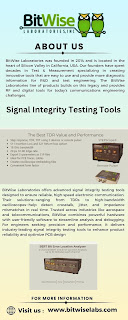How to Test PCB Traces with a TDR – BitWise Laboratories
Testing PCB
traces accurately is critical for ensuring signal integrity, especially in
high-speed circuit designs. One of the most reliable methods for this is using
a Time Domain Reflectometer (TDR). If you’re wondering how to test PCB traces
with a TDR, BitWise Laboratories provides
advanced solutions and guidance to help engineers and manufacturers achieve
precise testing results.
A TDR works
by sending a fast electrical pulse down a trace and measuring the reflections
caused by any impedance changes. These reflections can indicate issues like
open circuits, shorts, or impedance mismatches along the trace. By analyzing
the reflected waveform, engineers can identify the exact location and nature of
the fault, ensuring that design and manufacturing defects are corrected early.
Our testing
systems and expertise help clients measure trace length, impedance consistency,
and discontinuities with exceptional accuracy. Knowing how to test PCB traces with a TDR not only
improves performance but also reduces costly redesigns. We recommend performing
TDR testing during both the prototype and production stages to maintain
high-quality standards.
In today’s
high-frequency electronics, even minor impedance variations can impact signal
quality. That’s why BitWise Laboratories emphasizes precision TDR analysis to
ensure every PCB meets design expectations. With expert tools, detailed data
visualization, and professional support, engineers can rely on us for
dependable testing and validation of their electronic designs.




Comments
Post a Comment